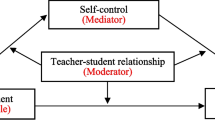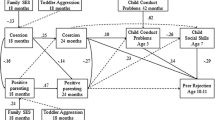Abstract
Child attachment to parents has been shown in the literature to reduce the likelihood of problem behaviors through enhancing resiliency. Research examining attachment and its relationship to antisocial behavioral outcomes in adolescents has been shaped largely by social control theorists who have theorized that attachment to prosocial others inhibits the expression of antisocial behavioral outcomes (Hirschi, 1969). This paper seeks to expand the literature by investigating the development of child attachment to parent(s) during the early elementary school years as specified theoretically by the social development model (Catalano & Hawkins, 1996). Using structural equation modeling, the results support the theoretical model as proposed by the social development model. School-aged children's attachment to parents can be successfully predicted by constructs outlined in the social development model. Finally, implications for interventions that enhance child attachment to parent(s) are discussed.
Similar content being viewed by others
REFERENCES
Akers, R. L. (1977). Deviant behavior: A social learning approach (2nd ed.). Belmont, CA: Wadsworth Press.
Akers, R. L. (1998). Social learning and social structure: A general theory of crime and deviance. Boston: Northeastern University Press.
Antonucci, T. C., & Akiyama, H. (1994). Convoys of attachment and social relations in children, adolescents, and adults. In F. Nesterman, K. Hurrelmann, et al. (Eds.), Prevention and intervention in childhood and adolescence. Vol. 16. Social networks and social support in childhood and adolescence (pp. 37–52). Berlin, Germany: Walter De Gruyter.
Armsden, G. C., & Greenberg, M. T. (1987). The Inventory of Parent and Peer Attachment: Individual differences and the relationship to psychological well-being in adolescence. Journal of Youth and Adolescence, 16, 427–454.
Bandura, A. (1977). Social learning theory. Englewood Cliffs, NJ: Prentice-Hall.
Bentler, P. M. (1992). On the fit of models to covariances and methodology to the Bulletin. Psychological Bulletin, 112, 400–404.
Bentler, P. M. (1993). EQS: Structural equations program manual. Los Angeles, CA: BMDP Statistical Software, Inc.
Byrne, B. (1994). Structural equation modeling withEQSandEQS/ Windows: Basic concepts, applications and programming. Thousand Oaks, CA: Sage.
Catalano, R. F., Gainey, R. R., Fleming, C. B., Haggerty, K. P., & Johnson, N. O. (1999a). An experimental intervention with families of substance abusers: One-year follow-up of the Focus on Families Project. Addiction, 94(2), 241–254.
Catalano, R. F., & Hawkins, J. D. (1996). The social development model: A theory of antisocial behavior. In J. D. Hawkins (Ed.), Delinquency and crime: Current theories (pp. 149–197).New York: Cambridge University Press.
Catalano, R. F., Kosterman, R., Hawkins, J. D., Newcomb, M. D., & Abbott, R. D. (1996). Modeling the etiology of adolescent substance use: A test of the social development model. In E. H. Czajkoski,& H. R. White (Eds.), Journal of Drug Issues: Empirical Validity of Theories of Drug Abuse, 26(2), 429–455. Tallahassee: JDI.
Catalano, R. F., Oxford, M., Harachi, T. W., Abbott, R. D., Haggerty, K. P. (1999b). A test of the social development model to predict problem behavior during the elementary school period. Criminal Behaviour and Mental Health, 9, 40–57.
Chamberlain, P., & Patterson, G. R. (1995). Discipline and child compliance in parenting. In M. H. Bornstein, (Ed.), Handbook of parenting volume 4: Applied and practical parenting (pp. 205–225).Mahwah, NJ: Lawrence Erlbaum Associates.
Cheney, D., Abbott, R. D., Hawkins, J. D., Catalano, R. F., Neel, R. S., & Peterson, P. (1997). The influence of the family, peer and school bond on school success and failure of middle school students. Unpublished manuscript.
Coble, H. J., Gantt, D. L., & Mallinckrodt, B. (1996). Attachment social competency, and the capacity to use social support. In G. R. Pierce, B. R. Sarason, et al. (Eds.), Plenum series on stress and coping. Handbook of social support and the family (pp. 141–172). New York: Plenum Press.
Elliott, D. S. (1994). Serious violent offenders: Onset, developmental course, and termination: The American Society of Criminology 1993 Presidential Address. Criminology, 32(1), 1–22.
Elliott, D. S., Huizinga, D., & Ageton, S. S. (1985). Explaining delinquency and drug use. Beverly Hills, CA: Sage.
Farrington, D. P., & Hawkins, J. D. (1991). Predicting participation, early onset, and later persistence in officially recorded offending. Criminal Behaviour and Mental Health, 1, 1–33.
Greenberg, M. T. (1999). Attachment and psychopathology in childhood. In J. Cassidy, & P. R. Shaver (Eds.), Handbook of attachment theory and research. New York: Guilford.
Greenberg, M. T., Siegel, J. M., & Leitch, C. J. (1983). The nature and importance of attachment relationships to parents and peers during adolescence. Journal of Youth and Adolescence, 2(5), 373–386.
Greenberg, M. T., Speltz, M. L., & DeKlyen, M. (1993). The role of attachment in the early development of disruptive behavior problems. Development and Psychopathology 5, 191–213.
Haggerty, K. P., Catalano, R. F., Harachi, T. W., & Abbott, R. D. (1998). Preventing adolescent problem behaviors: A comprehensive intervention description. Criminologie, 31(1), 25–47
Hawkins, J. D., Catalano, R. F, Jones, G., & Fine, D. N. (1987). Delinquency prevention through parent training: Results and issues from work in progress. In J. Q. Wilson & G. C. Loury (Eds.), From children to citizens: Vol. 3. Families, schools, and delinquency prevention (pp. 186–204). New York: Springer-Verlag.
Hawkins, J. D., Catalano, R. F., Kosterman, R., Abbott, R. D., & Hill, K. G. (1999). Preventing adolescent health-risk behaviors by strengthening protection during childhood. Archives of Pediatrics & Adolescent Medicine, 153(3), 226–234.
Hirschi, T. (1969). Causes of delinquency. Berkeley: University of California Press.
Kenny, M. (1994). Quality and correlates of parental attachments among late adolescents. Journal of Counseling & Development, 72, 399–403.
Kosterman, R., Hawkins, J. D., Spoth, R., Haggerty, K. P., & Zhu, K. (1997). Effects of a preventive parent training intervention on observed family interactions: Proximal outcomes from Preparing for the Drug Free Years. Journal of Community Psychology, 25(4), 337–352.
Krohn, M. D., & Massey, J. L. (1980). Social control and delinquent School-Aged Child Attachment to Parents 69 behavior: An examination of the elements of the social bond Sociological Quarterly, 21, 529–543.
Learner, D., & Kruger, L. (1997). Attachment, self-concept, and academic motivation. American Journal of Orthopsychiatry, 67(3), 485–492.
Marcus, R. F., & Betzer, P. D. (1996). Attachment and antisocial behavior in early adolescence. Journal of Early Adolescence, 16(2), 229–248.
MacCallum, R. C., Browne, M. W., & Sugawara, H. M. (1996). Power analysis and determination of sample size for covariance structure modeling. Psychological Methods, 1(2), 130–149.
Newcomb, M. D., & Bentler, P. M. (1988). Impact of adolescent drug use and social support on problems of young adults: A longitudinal study. Journal of Abnormal Psychology, 97, 64–75.
Nye, F. I. (1958). Family relationship and delinquency behavior. New York: John Wiley and Sons.
Rankin, J. H., & Kern, R. (1994). Parental attachments and delinquency. Criminology, 32(4), 495–515.
Rankin, J. H., & Wells, E. (1990). The effect of parental attachments and direct controls on delinquency. Journal of Research in Crime and Delinquency, 27, 140–165.
Resnick, M. D., Bearman, P. S., Blum, R. W., Bauman, K. E., Harris, K. M., Jones, J., Tabor, J., Beuhring, T., Sieving, R. E., Shew, M., Ireland, M., Bearinger, L. H., & Udry, J. R. (1997). Protecting adolescents from harm: Findings from the National Longitudinal Study on Adolescent Health. Journal of the American Medical Association, 278(10), 823–832.
Rice, K. G., Cunningham, T. J., & Young, M. B. (1997). Attachment to parents, social competence, and emotional well being: A comparison of black and white late adolescents. Journal of Counseling Psychology, 44(1), 89–101.
Rutter, M. (1990). Psychosocial resilience and protective mechanisms. In J. Rolf, A. S. Masten, D. Cicchetti, K. H. Nuechterlein, & S. Weintraub (Eds.), Risk and protective factors in the development of psychopathology (pp. 181–214). Cambridge, England: Cambridge University Press.
Sokol-Katz, R. J., Dunham, R., & Zimmerman, R. (1997). Family structure versus parental attachment in controlling adolescent deviant behavior: A social control model. Adolescence, 32(125), 199–215.
Spoth R., Redmond C., Haggerty K., & Ward T. (1995). A controlled parenting skills outcome study examining individual difference and attendance effects. Journal of Marriage and the Family, 57, 449–464.
Spoth R., Redmond C., Shin C., Lepper H., Haggerty K., & Wall M. (1998). Risk moderation of proximal parent and child outcomes of a universal family-focused preventive intervention: A test and replication. American Journal of Orthopsychiatry, 68(4), 565–579.
Webster-Stratton, C. (1984). Randomized trial of two parent-training programs for families with conduct disordered children. Journal of Cosulting and Clinical Psychology, 52, 666–678.
Webster-Stratton, C. (1994). Advanced videotape parent training: A comparison study. Journal of Consulting and Clinical Psychology, 62(3), 583–593.
Webster-Stratton, C., & Fjone, A. (1989). Interactions of mothers and fathers with conduct problem children: Comparison with a nonclinic group. Public Health Nursing, 6(4), 218–223.
Werner, E. E. (1989). High-risk children in young adulthood: A longitudinal study from birth to 32 years. American Journal of Orthopsychiatry, 59, 72–81.
Author information
Authors and Affiliations
Rights and permissions
About this article
Cite this article
Oxford, M.L., Harachi, T.W., Catalano, R.F. et al. Early Elementary School-Aged Child Attachment to Parents: A Test of Theory and Implications for Intervention. Prev Sci 1, 61–69 (2000). https://doi.org/10.1023/A:1010028113950
Issue Date:
DOI: https://doi.org/10.1023/A:1010028113950




